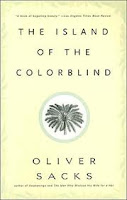by Oliver Sacks
 This is one of the most interesting books by Oliver Sacks I've read yet. In The Island of the Colorblind, Sacks travels with a few colleagues to the remote islands of Pingelap and Pohnpei where a large percentage of the population suffered from complete color-blindness. He was curious to study this phenomenon and see how the local culture might have adapted itself to having so many people with a color disability. The later part of the book tackles a different subject, as Sacks goes to Guam, another remote island with a high incidence of a mysterious disease called lytico-bodig. For decades doctors and scientists have been trying to find the cause of this degenerative neurological disease. The strangeness of lytico-bodig was that it seemed to run in families, mostly affected people who were native to or had visited the island (very rarely were cases found in other countries) and apparently hid dormant in the body for a long time, symptoms manifesting themselves suddenly years after whatever infecting agent had been encountered. The number of cases peaked in the 1940's and 50's, and after 1961 no more people contracted the disease. All kinds of things have been investigating as possibly causing lytico-bodig, from something toxic concentrated in fish to abnormally high levels of mineral content in water to a virus spread by an animal that has vanished from the island. But all the scientists (Sacks included) kept coming back to the cycad trees: at times the islanders made a special flour out of the seeds, which were highly poisonous but carefully prepared to removed the toxin. Over and over research has studied different contents of the cycad seed, but always drawn a blank. From reading around a bit, I found that after publishing this book, Sacks came up with a theory that eating bats which themselves had eaten cycad seeds, could have given people high levels of the toxin (the natives ate so many bats they became extinct on the island). More than just medical speculation though, the final part of the book is also an ode to the cycads, as Sacks admired these ancient plants and was curious about all aspects of their biology. Island of the Colorblind contains liberal notes in the back, which are just as interesting as the main text, so I kept a second bookmark in the back to flip to the notes whenever they were indicated.
This is one of the most interesting books by Oliver Sacks I've read yet. In The Island of the Colorblind, Sacks travels with a few colleagues to the remote islands of Pingelap and Pohnpei where a large percentage of the population suffered from complete color-blindness. He was curious to study this phenomenon and see how the local culture might have adapted itself to having so many people with a color disability. The later part of the book tackles a different subject, as Sacks goes to Guam, another remote island with a high incidence of a mysterious disease called lytico-bodig. For decades doctors and scientists have been trying to find the cause of this degenerative neurological disease. The strangeness of lytico-bodig was that it seemed to run in families, mostly affected people who were native to or had visited the island (very rarely were cases found in other countries) and apparently hid dormant in the body for a long time, symptoms manifesting themselves suddenly years after whatever infecting agent had been encountered. The number of cases peaked in the 1940's and 50's, and after 1961 no more people contracted the disease. All kinds of things have been investigating as possibly causing lytico-bodig, from something toxic concentrated in fish to abnormally high levels of mineral content in water to a virus spread by an animal that has vanished from the island. But all the scientists (Sacks included) kept coming back to the cycad trees: at times the islanders made a special flour out of the seeds, which were highly poisonous but carefully prepared to removed the toxin. Over and over research has studied different contents of the cycad seed, but always drawn a blank. From reading around a bit, I found that after publishing this book, Sacks came up with a theory that eating bats which themselves had eaten cycad seeds, could have given people high levels of the toxin (the natives ate so many bats they became extinct on the island). More than just medical speculation though, the final part of the book is also an ode to the cycads, as Sacks admired these ancient plants and was curious about all aspects of their biology. Island of the Colorblind contains liberal notes in the back, which are just as interesting as the main text, so I kept a second bookmark in the back to flip to the notes whenever they were indicated.Rating: 4/5 ........ 312 pages, 1996
More opinions at:
book addiction
Oh my! This does sound like a really interesting book, and like one that I just have to read! I have read other books by this author and thing he has an amazing talent for making science interesting and compelling. Very nice review. This one goes on my list!
ReplyDeleteThis sounds really interesting! And Sacks is a pretty good writer too. I'm going to have to check and see if my library has this one.
ReplyDeleteI've yet to read any of Sacks' books, but my husband loves him and luckily has a stack for me to choose from when I finally get around to it. This one sounds really good...though honestly, I think all of his books do.
ReplyDeleteOoooh, and I'm so excited to see you're reading Rats! I've been wanting to read that one for years...can't wait to hear what you think about it!
I like the stories Sacks chooses to write about. I heard about this story in science class a long time ago, but I've never actually read the details. "The Island of the Colorblind" sounds absolutely fascinating.
ReplyDelete